济慈诗歌美学赏析
济慈名诗《秋颂》的美学特色解析
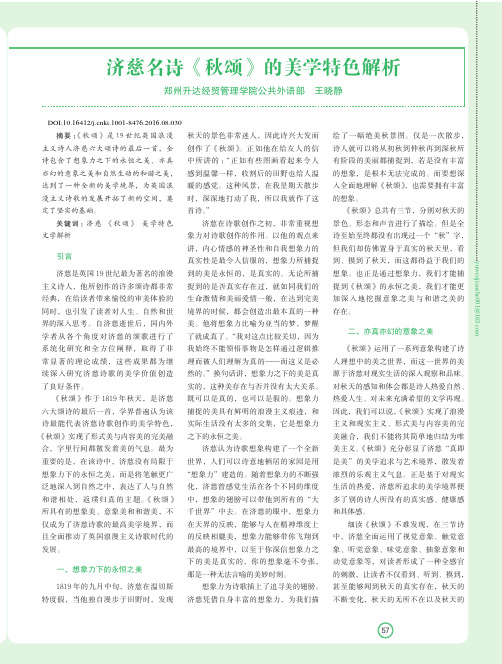
yuwenjianshe001@57济慈名诗《秋颂》的美学特色解析郑州升达经贸管理学院公共外语部 王晓静摘要:《秋颂》是19世纪英国浪漫主义诗人济慈六大颂诗的最后一首,全诗包含了想象力之下的永恒之美、亦真亦幻的意象之美和自然生动的和谐之美,达到了一种全新的美学境界,为英国浪漫主义诗歌的发展开拓了新的空间,奠定了坚实的基础。
关键词:济慈 《秋颂》 美学特色 文学解析引言济慈是英国19世纪最为著名的浪漫主义诗人,他所创作的许多颂诗都非常经典,在给读者带来愉悦的审美体验的同时,也引发了读者对人生、自然和世界的深入思考。
自济慈逝世后,国内外学者从各个角度对济慈的颂歌进行了系统化研究和全方位阐释,取得了非常显著的理论成绩,这些成果都为继续深入研究济慈诗歌的美学价值创造了良好条件。
《秋颂》作于1819年秋天,是济慈六大颂诗的最后一首,学界普遍认为该诗最能代表济慈诗歌创作的美学特色,《秋颂》实现了形式美与内容美的完美融合,字里行间都散发着美的气息。
最为重要的是,在该诗中,济慈没有局限于想象力下的永恒之美,而是将笔触更广泛地深入到自然之中,表达了人与自然和谐相处,返璞归真的主题。
《秋颂》所具有的想象美、意象美和和谐美,不仅成为了济慈诗歌的最高美学境界,而且全面推动了英国浪漫主义诗歌时代的发展。
一、想象力下的永恒之美1819年的九月中旬,济慈在温切斯特度假,当他独自漫步于田野时,发现秋天的景色非常迷人,因此诗兴大发而创作了《秋颂》。
正如他在给友人的信中所讲的:“正如有些图画看起来令人感到温馨一样,收割后的田野也给人温暖的感觉。
这种风景,在我星期天散步时,深深地打动了我,所以我就作了这首诗。
”济慈在诗歌创作之初,非常重视想象力对诗歌创作的作用。
以他的观点来讲,内心情感的神圣性和自我想象力的真实性是最令人信服的,想象力所捕捉到的美是永恒的,是真实的。
无论所捕捉到的是否真实存在过,就如同我们的生命激情和美丽爱情一般,在达到完美境界的时候,都会创造出最本真的一种美。
济慈诗歌生态自然观解读
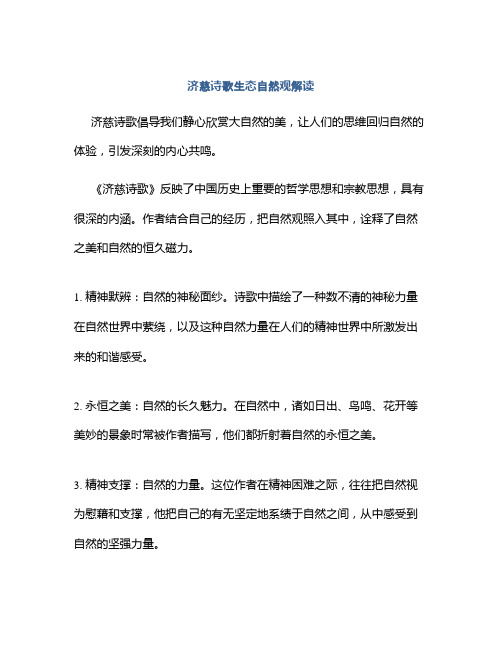
济慈诗歌生态自然观解读
济慈诗歌倡导我们静心欣赏大自然的美,让人们的思维回归自然的体验,引发深刻的内心共鸣。
《济慈诗歌》反映了中国历史上重要的哲学思想和宗教思想,具有很深的内涵。
作者结合自己的经历,把自然观照入其中,诠释了自然之美和自然的恒久磁力。
1. 精神默辨:自然的神秘面纱。
诗歌中描绘了一种数不清的神秘力量在自然世界中萦绕,以及这种自然力量在人们的精神世界中所激发出来的和谐感受。
2. 永恒之美:自然的长久魅力。
在自然中,诸如日出、鸟鸣、花开等美妙的景象时常被作者描写,他们都折射着自然的永恒之美。
3. 精神支撑:自然的力量。
这位作者在精神困难之际,往往把自然视为慰藉和支撑,他把自己的有无坚定地系绩于自然之间,从中感受到自然的坚强力量。
4. 互动感知:自然作用之精妙。
济慈诗歌也把人与自然之间的互动感知表现得晰明细腻,以一种深刻的方式,体现了自然作用中精妙的自然规律。
通过《济慈诗歌》,我们可以深刻地理解自然的神奇、永恒、慰藉和支撑力。
它从一个全新的角度解析了自然的规律,激发了我们去感悟自然之美及与自然和谐相处的乐趣。
夜莺颂济慈赏析

夜莺颂济慈赏析《夜莺颂》是英国诗人约翰·济慈的诗作。
全诗共八节。
开始写诗人自己听莺歌而置身瑰丽的幻想境界。
继而写纵饮美酒,诗兴大发,凭诗意遐想,随夜莺飘然而去,深夜醉卧花丛,缕缕芳香袭面而来,诗人陶然自乐,心旷神怡,愿就此离别人世。
人都有一死,而夜莺的歌却永世不灭。
想到此,梦幻结束,重返现实。
在济慈看来,他生活于其中的社会是庸俗、虚伪和污浊肮脏的,而永恒的大自然则绮丽秀美、清新可爱。
因而对丑的鞭挞和对美的追求构成了他抒情诗的基调。
评论家认为诗人以夜莺的歌声象征大自然中永恒的欢乐,并与现实世界中人生短暂、好景不长相对照。
诗人把主观感情渗透在具体的画面中,以情写景,以景传情,意境独特新奇,不落俗套。
通篇由奇妙的想象引领,写来自然、流畅。
另外此诗也是浪漫主义抒情诗歌中的力作。
济慈在《夜莺颂》中通过奇妙的想象,将读者带入一个瑰丽的幻想境界。
诗中,夜莺的歌声成为了连接诗人与大自然之间的纽带,让诗人暂时忘却现实的烦恼,沉浸在美好的自然景观中。
济慈通过夜莺的歌声,表达了对大自然美景的热爱和对人生苦短的感慨。
诗中描绘的自然景象如山毛榉的葱绿和阴影、夏夜的温柔月光等,都充满了诗意和美感,让人仿佛置身于一个理想的乐园之中。
《夜莺颂》的创作背景,1818年年底,23岁的济慈结识了他的邻居芬妮·布朗妮小姐。
他们恋爱的最初半年,济慈生活在幸福之中。
他像一个健康人那样,常常同芬妮远远地散着步,度过愉快的时光。
这半年也成了诗人创作最旺盛的时期。
这首《夜莺颂》是翌年春天的一个早晨,诗人坐在布朗妮家中花园的梅树下,听到夜莺的啼声后,不禁心旷神怡,诗兴勃发,不到三个小时,一气呵成。
济慈患有肺病,这给他的爱情生活笼罩上一层忧郁的阴影。
他曾写道:“在我的散步中,我有两件极喜欢思索的事,你(指芬妮)的可爱与我的死的时间。
”因此,他的诗中常常流露出哀伤、悲凉的情绪。
济慈《希腊古瓮颂》的美学解读

济慈《希腊古瓮颂》的美学解读
想起了古希腊文学家艾梅洛尼斯·洛克贝尔-帕利斯的《希腊古瓮颂》,便会
被其中淋漓尽致的美学魅力所折服,此篇作品拘留住古希腊文学的精华,以及文学家个人的心血,其中有了丰富的美学内涵。
《希腊古瓮颂》以一个充满阳光的希腊小镇有关的故事作为Wordis,整个市
民用传统的技艺将一只古瓮装饰得很漂亮,本质上,作品凸显出古希腊文学的价值:以节日的热烈和家园的宁静来庆贺生活的美好。
作者对古瓮的周围环境进行了形象而又真实地描述,巧妙地把正念与神话融为一体。
特别要指出的是,作者将古瓮与黎明、月亮和阳光这些元素紧紧连接在一起,使得古瓮有了更强烈的寓意。
例如:“月光充斥在古瓮上,庄严而真实,仿佛把外部世界留在边缘,带来了一种迷人的宁静”。
也暗示了古希腊文学的精神意蕴:热情追求完美。
此外,作者充分发挥想象力,运用符号语言将此故事上升到一种更高的层次与
范畴,一切发生的场景和人物的话语,都有可能起到一种类似于智性的作用,这在其他作品里找不到,是真正的古文学的魅力所在。
综上所述,古希腊文学家艾梅洛尼斯·洛克贝尔-帕利斯的《希腊古瓮颂》是
一篇非常优秀的古文学作品,其中蕴含着丰富的美学内涵,既有雷同神话的传统价值,又融入了对完美的寄寓,将文学提升到另一个高度,这正是《希腊古瓮颂》所表达的美学意义。
济兹诗歌的美学欣赏

济兹.英国19世纪最伟大的浪漫主义诗人之一,一度被看作是能与莎士比亚相媲美。
他是英国诗歌史上创作时间最短,但却取得了辉煌的诗歌创作成就的诗人。
济兹对美有着惊人的感悟力和敏锐的观察力,他的诗歌语言美轮美灸,充满丰富的想象力,完美地体现了西方浪漫主义诗歌的特色。
一、济兹诗歌的美学理念济兹在他诗歌创作伊始,公开表达了自己的美学思想。
济兹在给其弟弟乔治的信中直接便到了其美学思想——消极才能理论在济兹的这个观点里,他强调的是诗人进入写作或者诗歌创作的一种方式,一种状态,即一种能沉迷于对感观和心灵的美感享受之中,而并不急于去弄清楚事情的本质真相的能力。
只有拥有了这种能力,诗人的想象力才会更丰富,才能更客观、更真实地去感受自然界的美好所在。
济兹的这一美学思想要求诗人要真实地反映世间万象之矛盾,芸芸众生之苦乐,从而创造文学作品的真实性和美感。
济兹认为;只有同时反映生活的美与丑、光明与黑暗,才能真正具有艺术的魅力。
在济兹最著名的咏物诗歌作品《希腊古瓮颂》中,诗人以“美即是真,真即是美”结尾,充分表达了诗人的这一美学理念。
二、济兹诗歌的自然美感济兹“消极才能”的美学思想决定他的诗歌中反映的内容不是诗人主观的幻想臆造而是存在的自然。
自然界中一切美好的事物都是济兹诗歌创作的源泉。
在济兹短暂的一生中,孤苦的身世和孤傲的心灵使他具有了对自然界的强烈追求和责任感。
济兹怀着一颗慈善之心、感恩之心去关爱自然,赞美自然。
在济兹笔下,自然无限头独子,是一切艺术创作取之不尽用之不竭的灵感源泉。
他的很多诗歌用优美的描写栩栩如生地把我们带到一个惟妙惟肖的自然王国,更将我们的心灵带往美好的自然殿堂。
在诗歌《幻想》当中,诗人有这样一段经典的自然描写:啊,此时此刻一一听:这是早春四月云雀的争呜,那叫喊着的忙碌的山鸟,正在把树枝和稻草寻找。
雏菊、金盏花和篱边初开的樱草花,淡淡的黄色映衬着白羽般的野百合;还有风信子,五月中旬的花王,每一片树叶,没一朵鲜花在同一阵雨中把珍珠披挂。
美即是真,真即是美——济慈诗歌中的美学赏析

美即是真,真即是美——济慈诗歌中的美
学赏析
济慈,巴西最著名的诗人之
一,他的诗歌在世界上享有极高的声誉。
济慈诗歌中所描绘的美是一种真实的美,它不是假象,而是一种真实的美,它来自于自然,也可以从自然中获得。
他的一些作品,如《大地的美》,突出了大自然的美丽,通过讽刺的语言,描绘了大自然的美丽。
他的诗歌中有着一种清新的气息,描绘的大自然的美与真实无关,而是来自于自然本身,也可以从自然中获得。
此外,济慈的诗歌中也有着一种真实与虚幻相结合的美,他在诗歌中把虚幻与真实相融合,把一些真实的生活细节融入其中,用一种虚幻的语言来表达,从而使得诗歌更加有深度,更加生动形象。
济慈诗歌中的美学观,也可以从其作品中得出,他强调的是美的真实性,他坚持认为美是真实的,它来自于自然,多姿多彩,充满色彩,这种美,不仅仅是审美观念,更是一种心灵的体验,它把真实与虚幻相结合,从而使得美更加纯粹,更加真实。
总之,济慈诗歌中的美学赏析,表达的是一种真实的美,它不是虚构,而是来自于自然,它把真实与虚幻相结合,从而使得美更加真实、更加纯粹。
济慈诗歌中的美,是一种有深度的、有意义的美,它不但具有实用性,而且能够激发人们的情感,从而使人们能够感受到生活的真实和美好。
约翰·济慈诗歌中的死亡美学研究

死亡是济慈诗歌的主题,济慈对死亡的思考也必然地影响到他的 诗歌创作。在济慈的诗歌中,对死亡的描写总是折射出一种特殊 的美。
本文主要分为五章。第一章为绪论部分,主要介绍济慈生平及其 诗歌以及文献综述,总结前人研究成果,提出本文的独创性。
第二章主要讨论济慈诗歌中死亡的美学表现,死亡是平静美丽的、 伤感浪漫的、也是超脱和解放的。第三章探讨了济慈诗歌中死 亡美的表现手法。
约翰·济慈诗歌中的死亡美学研究
约翰·济慈是19世纪英国浪漫主义的著名代表诗人。济慈以浪 漫伤感的笔触书写出了许多不朽诗篇,是英国乃至世界文学中的 瑰宝。
然而济慈在他生前并未得到许多关注,甚至在他死后的二十年间 依然未受到重视。随着时间的流逝,济慈的作品越来越受到文学 界的重视。
前人对济慈的研究主要集中在各个理论框架下的诗歌分析,结构 主义、女性主义、生态主义、新批评主义等都角度都有学者做 过阐述。本文着重研究济慈诗歌的死亡美学。
通过本文的分析得的展现又离不开济慈精 湛的诗艺。阅读济慈的诗歌中死亡的描写常常在读者心中产生 深深的美感,给读者留下深刻的印象。
对济慈诗歌死亡美学的分析,可以帮助更好地理解济慈的诗歌, 品味其中蕴含的美感,从而更深刻地理解济慈的诗歌,更全面地 了解这位诗人。
济慈把颂诗作为其诗歌创作的主要形式,修辞手法和意象的灵活 运用也为表现死亡的美做出了重要贡献。第四章讨论了死亡美 的表达效果。
阅读济慈的诗歌,读者能够经常感受到其诗歌中充满死亡的气息, 济慈对死亡的描写如此美丽以至于读者会产生对死亡的自我认 同感;而在这之后又会对生命产生更强烈的热爱。第五章为本 文的结论。
济慈秋颂深度解析

济慈的《秋颂》是一首富有深度的诗歌,以下是对它的详细解析:主题与结构:《秋颂》是英国浪漫主义诗人约翰·济慈于1819年9月创作的一首诗歌。
诗歌的主题是赞美秋天,展现秋天的成熟之美和收获之美。
诗歌分为三个部分,每个部分都有不同的重点,但都与秋天相关。
秋天的成熟之美:在第一节中,诗人描绘了秋天的成熟之美。
他通过拟人化的手法,将秋天描绘成一个与太阳合谋,催动果实成熟的形象。
诗人用“缀满”写葡萄果实之丰,用老树“背负着”形容苹果的结实硕大,用熟味“透进”心中,形容果实的甜美。
这些动词的运用,无不精准传神。
通过这些描绘,诗人展现了秋天的盎然生机和成熟之美。
秋天的收获之美:在第二节中,诗人捕捉了秋天在田野、打麦场、田垄、小溪等场景里的身影,展现了秋天的收获之美。
诗人用速写般的语言,生动地描绘了秋天丰收的景象。
这些描绘让读者仿佛置身于秋天的田野之中,感受到秋天的丰饶和喜悦。
秋天的声音之美:在最后一节中,诗人写了秋天的声音之美。
昆虫歌唱、鸟儿呢喃、羊群咩叫,共同组成了美妙的音乐。
这些声音交织在一起,构成了秋天的交响乐。
诗人通过这些声音,让读者感受到秋天的宁静和和谐。
诗歌的艺术手法:济慈在《秋颂》中运用了多种艺术手法,包括拟人化、象征、比喻等。
这些手法的运用使得诗歌更加生动、形象,让读者能够更深入地感受到秋天的美。
诗歌的意义:《秋颂》不仅是一首赞美秋天的诗歌,更是一首表达对生活热爱和感恩的诗歌。
通过赞美秋天,诗人表达了对大自然、对生活的热爱和感恩之情。
同时,诗歌也传递了一种积极向上的生活态度,即珍惜当下、感恩生活、热爱自然。
总的来说,《秋颂》是一首富有深度和美感的诗歌,通过赞美秋天展现了生活的美好和丰富。
济慈诗歌中的浪漫主义表现与思想体现
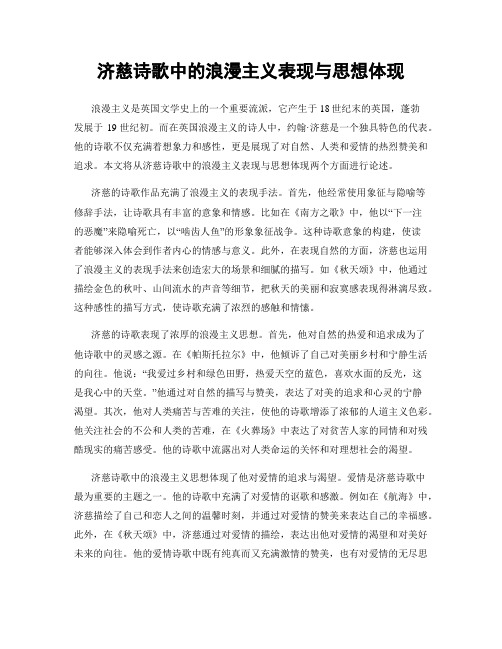
济慈诗歌中的浪漫主义表现与思想体现浪漫主义是英国文学史上的一个重要流派,它产生于18世纪末的英国,蓬勃发展于19世纪初。
而在英国浪漫主义的诗人中,约翰·济慈是一个独具特色的代表。
他的诗歌不仅充满着想象力和感性,更是展现了对自然、人类和爱情的热烈赞美和追求。
本文将从济慈诗歌中的浪漫主义表现与思想体现两个方面进行论述。
济慈的诗歌作品充满了浪漫主义的表现手法。
首先,他经常使用象征与隐喻等修辞手法,让诗歌具有丰富的意象和情感。
比如在《南方之歌》中,他以“下一注的恶魔”来隐喻死亡,以“啮齿人鱼”的形象象征战争。
这种诗歌意象的构建,使读者能够深入体会到作者内心的情感与意义。
此外,在表现自然的方面,济慈也运用了浪漫主义的表现手法来创造宏大的场景和细腻的描写。
如《秋天颂》中,他通过描绘金色的秋叶、山间流水的声音等细节,把秋天的美丽和寂寞感表现得淋漓尽致。
这种感性的描写方式,使诗歌充满了浓烈的感触和情愫。
济慈的诗歌表现了浓厚的浪漫主义思想。
首先,他对自然的热爱和追求成为了他诗歌中的灵感之源。
在《帕斯托拉尔》中,他倾诉了自己对美丽乡村和宁静生活的向往。
他说:“我爱过乡村和绿色田野,热爱天空的蓝色,喜欢水面的反光,这是我心中的天堂。
”他通过对自然的描写与赞美,表达了对美的追求和心灵的宁静渴望。
其次,他对人类痛苦与苦难的关注,使他的诗歌增添了浓郁的人道主义色彩。
他关注社会的不公和人类的苦难,在《火葬场》中表达了对贫苦人家的同情和对残酷现实的痛苦感受。
他的诗歌中流露出对人类命运的关怀和对理想社会的渴望。
济慈诗歌中的浪漫主义思想体现了他对爱情的追求与渴望。
爱情是济慈诗歌中最为重要的主题之一。
他的诗歌中充满了对爱情的讴歌和感激。
例如在《航海》中,济慈描绘了自己和恋人之间的温馨时刻,并通过对爱情的赞美来表达自己的幸福感。
此外,在《秋天颂》中,济慈通过对爱情的描绘,表达出他对爱情的渴望和对美好未来的向往。
他的爱情诗歌中既有纯真而又充满激情的赞美,也有对爱情的无尽思念和痛苦的表达。
明亮的星 诗歌 济慈

明亮的星诗歌济慈
明亮的星
明亮的星,但愿我能如你坚定——
但并非孤独地在夜空闪烁高悬,
睁着一双永不合拢的眼睛,
犹如苦修的隐士彻夜无眠,
凝视海水冲洗尘世的崖岸,
好似牧师行施净体的沐浴,
或正俯瞰下界的荒原与群山
被遮盖在轻轻飘落的雪罩里——
并非这样——却永远坚定如故,
枕卧在我美丽的爱人的胸膛,
永远能感到它的轻轻的起伏,
永远清醒,在甜蜜的不安中,
永远、永远听着她轻柔的呼吸,
永远这样生活——或昏厥而死去。
赏析:
《明亮的星》就是济慈在赴意大利的船上创作的,是济慈留给世人的最后一首诗。
诗人一生追求美和真,特别强调现世生活的感性美,这首《明亮的星》就体现了诗人对这种美的梦寐以求。
整首诗用强烈的对比手法,对照了两种“坚定不移”,以及两种不同的“永恒”:
明亮的星,孤悬中天,长夜独明,睁着一对永远不闭的“眼睛”,默默瞭望着人世间的一切变化,日复一日,坚定不移。
诗人敬佩明星这种坚定的毅力,却不欣赏它对世俗生活所采取的那种隐士一般冷漠的态度。
诗人要将明星那种坚定不移的毅力用来追求现世生活中青春与爱情的欢乐和甜美。
当诗人在爱河中感受着情人酥胸柔软的起伏,当两颗心灵的激荡为彼此带来爱的狂喜,当诗人在爱情的醇酒中泛着醉意静听情人均匀的呼吸声……哦,这是多么幸福和甜蜜啊!人生
匆匆,青春和爱情更是转瞬即逝,然而青春和爱情所带来的短暂的喜悦、甜美和陶醉,却远远胜过明亮的星投给世界的冷漠和傲慢,以及那种冷冰冰的永恒。
济慈的两首浪漫主义诗歌《夜莺颂》和《希腊古瓮颂》赏析

济慈的两首浪漫主义诗歌《夜莺颂》和《希腊古瓮颂》赏析
英国浪漫主义诗人、作家华兹华斯·米尔福特·维果洛的《夜莺颂》和《希腊
古瓮颂》,充满着浪漫气息,满载着情感丰沃的激情,分别赋于生活迷人的仪式感,以及抒发离别悲怆的精神色彩。
《夜莺颂》写出夜晚的自然风景,夏夜中的流动的繁华容颜、无穷无尽的绚烂
仙景,以及繁星在空中交相辉映,深夜对月映衬而不致苍白的场景,向晨曦里的踏青者宣告着持续的欢愉。
唯美的诗句营造出跳动灵魂的优雅意犹,愉悦的情绪溢满整首诗的动人之处,那恬淡的氛围让诗人在思绪飘荡中遥望天际,发掘夜晚深处藏起的身居景尔。
另一首诗歌《希腊古瓮颂》是维果洛发自内心的表达,描绘他离别希腊,离开
曾经数度间次踏上的西南岛,满腔思念之情从文字涌出,几许怅别之色,几许浪漫情怀融于宽广的地域中,厚重里表现出一个人内心深处对家乡述说的落寞,一颦一笑中言之有物,营造出深浅不一变化多端的感慨。
华兹华斯·米尔福特·维果洛的两首浪漫诗歌,用情绪漫滴的抒情力量惊艳文字,唤起深处的感受,表现出维果洛的清新想像力,暗示着这位美妙的诗人深情地述说人们对生活、家乡以及离别的深沉情思。
它们将唯美滋养着我们,让被日常繁琐所扰乱的心灵放松下来,享受浪漫诗歌带来的梦一般的惬意。
英国著名诗人济慈《每当我害怕时》,

引言概述:英国著名诗人济慈的诗歌作品以其深情和感人的描写而著称。
其中的诗集《每当我害怕时》中,他以独特的语言和意象,探讨了人类内心的恐惧、挣扎与希望。
本文将分析《每当我害怕时》的第二首诗,从不同角度解读其中的主题和意义。
正文内容:一、描绘人类的脆弱与困境1. 揭示诗中人物的孤独感:通过济慈对主人公内心的描写,展示了他独处时的物理和精神孤独。
2. 探讨对未来的忧虑:通过细腻的描写,济慈传达了主人公对未知世界的恐惧和不确定性。
3. 表达对人性的疑惑:济慈通过诗中的对话和思考,反映了他对人类本质的疑惑和困扰。
二、诗歌中的自我反思与追寻1. 探讨诗人自我认知的过程:济慈通过诗中的对话和自省,描述了他自我的追寻与成长的过程。
2. 表现对死亡的思考与追问:济慈通过描述主人公与死神的对话,探讨了人类对死亡的恐惧与期许。
3. 反思艺术与诗歌的力量:通过对诗歌本质的思考,济慈对艺术的意义进行了深入的探索和思考。
三、信念与希望的坚持1. 传达对生活的积极态度:济慈通过描写主人公的内心和外在,展现了对生活的热爱和积极面对的信念。
2. 强调希望与挣扎的重要性:济慈通过主人公的经历,强调了希望和奋斗在战胜困境中的重要作用。
3. 探索内心的出路与抉择:济慈通过描绘主人公的思考和抉择,展示了内心的变化和向上的力量。
四、自然与宇宙的关系描写1. 描绘自然景观的壮丽与变化:济慈通过对自然景物的描绘,展示了其壮美、流动和变幻无常的一面。
2. 探讨人与自然的联系:济慈通过揭示主人公与自然界的相互作用,表达了人与自然的密切关系与依赖。
3. 表现宇宙与人类命运的共通性:济慈将宇宙与人类的命运进行关联,并通过诗中的意象和隐喻,传递出普遍的人类情感和存在主题。
五、诗歌的形式与风格分析1. 分析诗的结构和韵律:济慈的诗歌以抒情诗为主,通过探讨主题和感受,运用诗的结构和韵律,增强诗歌的语言魅力。
2. 解读诗中的修辞手法:济慈在《每当我害怕时》中使用了丰富的修辞手法,如隐喻、比喻等,以增强诗歌的意境和表现力。
约翰·济慈《秋颂》的美学赏析
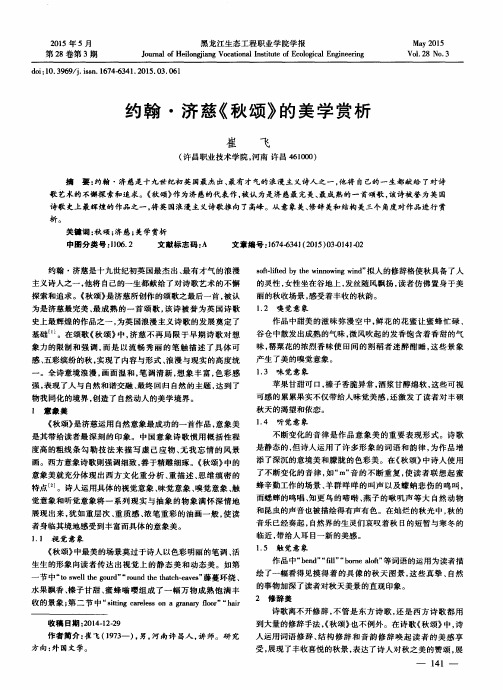
意象美就充分体 现 出西方 文化 重分 析 、 重描 述 、 思维 缜 密的
特点 。诗人运用具体 的视觉意象 、 味觉意象 、 嗅觉 意象 、 触 觉意象和听觉 意象将 一系 列现实 与抽 象 的物 美学赏析
中图分类号 : I 1 0 6 . 2 文献标志 码 : A 文章编号 : 1 6 7 4 - 6 3 4 1 ( 2 0 1 5 ) 0 3 - 0 1 4 1 02 -
约翰 ・ 济慈是十九世纪初英 国最杰 出 、 最 有才气 的浪漫
主义诗人之一 , 他将 自己的一生都献 给了对诗 歌艺术 的不懈
一
作 品中“ b e n d ” “ f i l l ” “ b o ne r a l o f t ” 等词语 的运用 为读者描
节中“ t o s w e l l t h e g o u r d ” “ r o u n d t h e t h a t c h — e a v e s ” 藤蔓环绕 、
1 意 象 美
秋天 的渴望 和依 恋。
1 . 4 听 觉 意 象
《 秋颂 》 是济慈运用 自然意象最成功 的一首 作品 , 意 象美 是其带给读者最 深 刻 的印象 。中 国意象 诗歌惯 用 概括 性程 度高的粗线 条勾 勒 技法 来 描 写虚 己应物 、 无我 忘 情 的风 景 画 。西方意象诗歌则 强调细致 , 善于精雕细琢 。《 秋颂》 中的
绘 了一幅看得见 摸得 着 的具像 的秋天 图景 , 这 些真 挚 、 自然
水 果飘香 、 榛 子甘甜 、 蜜 蜂嗡 嘤组 成 了一 幅万物 成熟 饱满 丰 收的景象 ; 第二节中“ s i t t i n g c a r e l e s s o n a g r a n a r y l f o o r …‘ h a i r
济慈诗歌唯美意境的营造手法

二、作品分析
全诗共八个诗节,格式规整,源自规范的颂歌体——贺拉斯体颂歌(Horatian odes),经济慈加以改动而成。每一诗节都分为两组:一组四行,加上一组六行,两组意义连贯,后一组或是对前一组的解释说明,或是前一组的意义引申,或是由前一组诗句而引发出的联想,两组含义契合,构成一个有机整体,各诗节的意义又相互照应,层层深入,描写了诗人由现实听到夜莺的歌声而进入冥想中的虚幻境界,又从虚幻走回现实中来,表达了诗人对人生疾苦的体会和同情,但同时也表现出他希望借诗、酒之力逃避现实的消极思想。
总的说来,济慈对声音的感悟和捕捉能力是超乎寻常的,并且能够得心应手地运用声音来帮助表达主题,使声音与内容、意境完美地融合在一起。
2.书写层
济慈在诗歌的书写方面比较规范,《夜莺颂》这首诗整体上比较符合诗歌的一般书写规律,但也有几处用首字母大写的方式来起到特定的作用:“Beauty”(L29)、“Love”(L30)、“Poesy”(L33)、“Death”(L52)四词首字母大写,这四项都是被诗人形象化了的抽象事物,在诗中诗人通过书写上的变异将抽象的事物比作生命体,把抽象呆板的说理转变成生动形象的描绘;“Queen-Moon”(L36)、“mid-May”(L48)两处的单词首字母大写表示拟人化,将无生命的事物比作人,增添了诗歌的情趣,也展示出诗人丰富的想像力;“South”(L15)处用了换喻修辞法,用地点代指该地出产的美酒,简洁明了;“Bird”(L61)的书写变异起到强调作用,把夜莺这一形象放大,表示诗人心目中夜莺的意义已远远超越了一只普通的、会唱歌的小鸟,而成为了诗人精神的向导,同时在这里诗人又是在向夜莺呼唤,而夜莺是一种理想化的美好生活的象征,因此这个单词书写上的突出似可表现出诗人内心世界对那种没有痛苦和忧愁的生活的强烈的渴望。
希腊神话语境下济慈的美学观评析

本文由导论、正文和结论三部分组成。主要内容如下:第一部 分是导论。
首先简单扼要的说明本文的写作目的,济慈的著作及其诗歌的 写作特点。其次阐述了国内外对济慈作品的研究成果及本文要 研究的内容的必要性。
第二部分是正文,由三部分组成:第一章首先系统分析希腊神 话对济慈美学思想的深刻影响。这种影响主要体现在为济慈的 美学思想提供丰富的素材及灵感来源,和赋予济慈诗歌神话唯 美主义意识等方面。
《恩底弥翁》是济慈早期的诗歌作品之一,在其被出版后遭受 了各界人士的批评,被认为是一部不反映现实而单纯追求美的 作品。但从诗歌中所反映的浪漫主义自然观和唯美主义爱情观 可以看出,深受希腊神话影响的济慈并不是单纯追求美的享乐 主义者。
而这首长诗无论从韵律还是用词上来看,并不是随意写成,而 是经过深思熟虑之后通过细腻的想象创作出来的。诗中大量的 感性想象和神话引用赋予了诗歌本身崇高的文学价值。
它是济慈在1818年前后创作的。在这首抒情长诗中,济慈认识 到了神话故事参与诗歌想象的伟大力量。
在《恩底弥翁》中,济慈通过描写神话人物的爱情故事,表达 其对唯美主义爱情观的赞美,而其中隐含的神秘主义色彩也与 唯美主义相得益彰。本文主要从唯美主义思想出发,以《恩底 弥翁》为例,对济慈的美学观进行评析。
希腊神话语境下济慈的美学观评析
十九世纪三十年代英国的浪漫主义诗人约翰·济慈是唯美主义 运动的先驱。他反对艺术的功利主义,主张纯艺术,提出“为 了艺术而艺术”的主张。
“美即是真,真即是美”是济慈美学思想的精粹。也是其从纯 粹的唯美主义者,积极的浪漫主义者回归到现实的集中体现。
济慈诗歌中的美学思想通过对神话意象的描写得到体现,并对 英国文坛乃是世界文坛美学的发展具有重大的历史意义。《恩 底弥翁》是济慈早期的作品部 分是结论,总结了本文的主要论点,写作目的及现实意义。
济慈及其《夜莺颂》的美学魅力
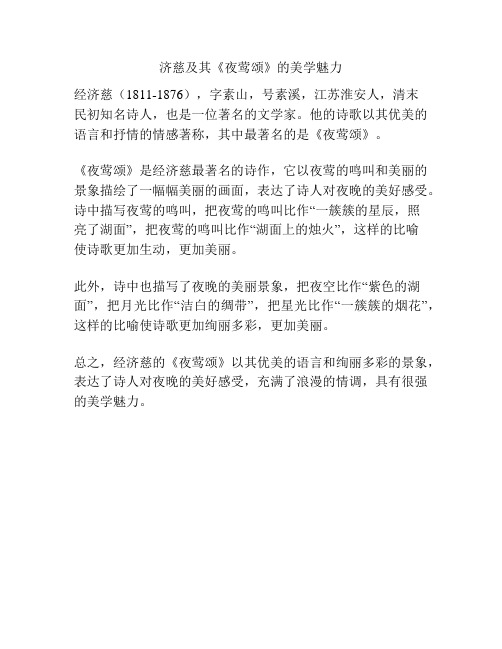
济慈及其《夜莺颂》的美学魅力
经济慈(1811-1876),字素山,号素溪,江苏淮安人,清末
民初知名诗人,也是一位著名的文学家。
他的诗歌以其优美的语言和抒情的情感著称,其中最著名的是《夜莺颂》。
《夜莺颂》是经济慈最著名的诗作,它以夜莺的鸣叫和美丽的景象描绘了一幅幅美丽的画面,表达了诗人对夜晚的美好感受。
诗中描写夜莺的鸣叫,把夜莺的鸣叫比作“一簇簇的星辰,照
亮了湖面”,把夜莺的鸣叫比作“湖面上的烛火”,这样的比喻
使诗歌更加生动,更加美丽。
此外,诗中也描写了夜晚的美丽景象,把夜空比作“紫色的湖面”,把月光比作“洁白的绸带”,把星光比作“一簇簇的烟花”,这样的比喻使诗歌更加绚丽多彩,更加美丽。
总之,经济慈的《夜莺颂》以其优美的语言和绚丽多彩的景象,表达了诗人对夜晚的美好感受,充满了浪漫的情调,具有很强的美学魅力。
to autumn济慈赏析
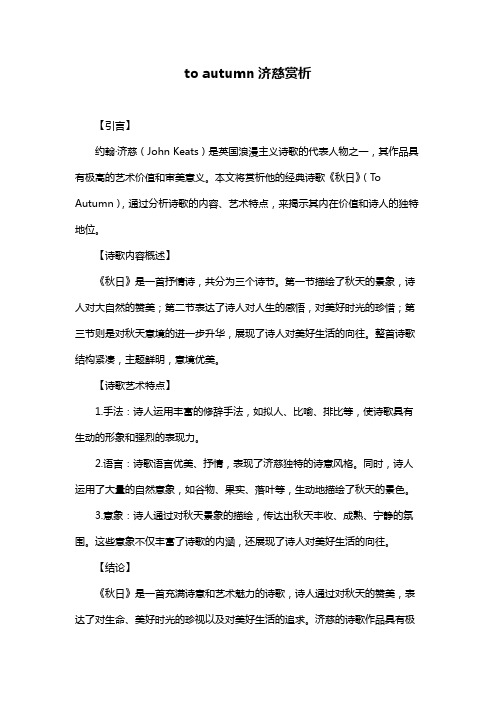
to autumn济慈赏析
【引言】
约翰·济慈(John Keats)是英国浪漫主义诗歌的代表人物之一,其作品具有极高的艺术价值和审美意义。
本文将赏析他的经典诗歌《秋日》(To Autumn),通过分析诗歌的内容、艺术特点,来揭示其内在价值和诗人的独特地位。
【诗歌内容概述】
《秋日》是一首抒情诗,共分为三个诗节。
第一节描绘了秋天的景象,诗人对大自然的赞美;第二节表达了诗人对人生的感悟,对美好时光的珍惜;第三节则是对秋天意境的进一步升华,展现了诗人对美好生活的向往。
整首诗歌结构紧凑,主题鲜明,意境优美。
【诗歌艺术特点】
1.手法:诗人运用丰富的修辞手法,如拟人、比喻、排比等,使诗歌具有生动的形象和强烈的表现力。
2.语言:诗歌语言优美、抒情,表现了济慈独特的诗意风格。
同时,诗人运用了大量的自然意象,如谷物、果实、落叶等,生动地描绘了秋天的景色。
3.意象:诗人通过对秋天景象的描绘,传达出秋天丰收、成熟、宁静的氛围。
这些意象不仅丰富了诗歌的内涵,还展现了诗人对美好生活的向往。
【结论】
《秋日》是一首充满诗意和艺术魅力的诗歌,诗人通过对秋天的赞美,表达了对生命、美好时光的珍视以及对美好生活的追求。
济慈的诗歌作品具有极
高的审美价值,他在英国文学史上具有重要地位。
to autumn济慈赏析
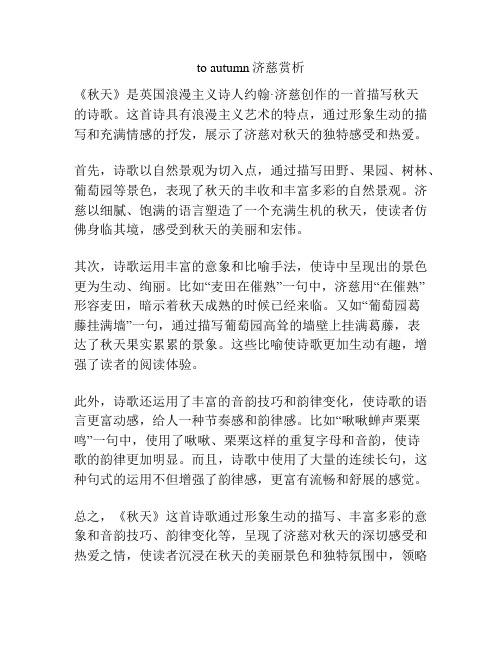
to autumn济慈赏析
《秋天》是英国浪漫主义诗人约翰·济慈创作的一首描写秋天
的诗歌。
这首诗具有浪漫主义艺术的特点,通过形象生动的描写和充满情感的抒发,展示了济慈对秋天的独特感受和热爱。
首先,诗歌以自然景观为切入点,通过描写田野、果园、树林、葡萄园等景色,表现了秋天的丰收和丰富多彩的自然景观。
济慈以细腻、饱满的语言塑造了一个充满生机的秋天,使读者仿佛身临其境,感受到秋天的美丽和宏伟。
其次,诗歌运用丰富的意象和比喻手法,使诗中呈现出的景色更为生动、绚丽。
比如“麦田在催熟”一句中,济慈用“在催熟”
形容麦田,暗示着秋天成熟的时候已经来临。
又如“葡萄园葛
藤挂满墙”一句,通过描写葡萄园高耸的墙壁上挂满葛藤,表
达了秋天果实累累的景象。
这些比喻使诗歌更加生动有趣,增强了读者的阅读体验。
此外,诗歌还运用了丰富的音韵技巧和韵律变化,使诗歌的语言更富动感,给人一种节奏感和韵律感。
比如“啾啾蝉声栗栗鸣”一句中,使用了啾啾、栗栗这样的重复字母和音韵,使诗
歌的韵律更加明显。
而且,诗歌中使用了大量的连续长句,这种句式的运用不但增强了韵律感,更富有流畅和舒展的感觉。
总之,《秋天》这首诗歌通过形象生动的描写、丰富多彩的意象和音韵技巧、韵律变化等,呈现了济慈对秋天的深切感受和热爱之情,使读者沉浸在秋天的美丽景色和独特氛围中,领略
到秋天的魅力。
这首诗歌不仅展示了济慈的艺术才华,更使人们对秋天产生了深刻的共鸣,将秋天上升到了一种情感的高度。
诗歌赏析:济慈--漫长的冬季

诗歌赏析:济慈--漫长的冬季漫长的冬季济慈漫长的冬季才尽,当浓雾不再低压着我们的平原,从温煦的南方就送来晴天,给病恹的天空除尽了斑污,这解除了痛苦的日子,急于享受权力,已披上五月的感觉,而眼睑却还有寒气在跳跃,像是玫瑰叶上滴溅的夏雨。
最恬静的思绪浮荡在心上,使人想起嫩叶、静静成熟的果实、屋檐上向往的秋阳、沙弗的面颊、睡婴的呼吸、沙漏中逐渐滴下的沙子、森林里的小河、诗人的死。
1817年1月31日(穆旦译)约翰·济慈(John Keats,1795—1821)是与拜伦、雪莱同时期的英国诗人,在英国浪漫主义诗坛中占据重要地位。
济慈的诗歌处处有生活的痕迹,他的诗作中有很多写给亲人、友人的赠诗,体现出济慈对亲情和友情的依恋与珍惜。
在《给我的弟弟乔治》一诗中,他说“今天我看见的奇迹很多……唉,但天空和海洋的奇迹算了什么,若不是联想到你?”在《给赠我以玫瑰的友人》一诗中,济慈直言“你的玫瑰来后,我的感官却迷于它们的甘美:它们有轻柔的声音,悄悄恳求和平、真理、和无尽友情的陶醉。
”济慈珍惜自然的每一缕馈赠,田野、平原、花园、群山在他的眼中都是令人欣喜和感恩的,甚至于一颗露珠都在济慈的诗中折射出耀眼的光明。
但济慈对亲情和友情的珍爱,又更甚于自然。
这位年轻的诗人拥有一颗多么善感且纯真的心灵啊!难怪能够在《希腊古瓮颂》中道出“美即是真,真即是美”的至理。
《漫长的冬季》写于1817年,正是济慈生命的末章阶段,诗中以压抑且漫长的冬季与温煦跳跃的春夏相对比,写出了诗人内心对温暖和阳光的渴盼。
这时的济慈,无论是经济还是健康都面临着威胁,所以非常热切的渴望寒冬离去,春夏降临。
诗歌虽只写了寒冬的浓雾,但低压、病恹、斑污等词都透露出了压抑的气息,人们对寒冬的畏惧、不耐跃然纸上。
诗歌花更多笔力去描绘春夏的各种生活情境,那些美好的事物、祥和的氛围、安逸的心境都是春夏的写照,这些看似平平无奇,非常常见的生活场景都是诗人对生活的热爱,他能从他人不注意的细节中领会生活的美好,也更加珍惜生活片刻的安宁。
- 1、下载文档前请自行甄别文档内容的完整性,平台不提供额外的编辑、内容补充、找答案等附加服务。
- 2、"仅部分预览"的文档,不可在线预览部分如存在完整性等问题,可反馈申请退款(可完整预览的文档不适用该条件!)。
- 3、如文档侵犯您的权益,请联系客服反馈,我们会尽快为您处理(人工客服工作时间:9:00-18:30)。
济慈诗歌美学赏析
摘要:济慈,作为19世纪最伟大的浪漫主义诗人之一,他的诗歌被一代代人所传颂,他的美学理念也深刻地影响了浪漫主义思潮的发展。
其颂诗被无数诗评家文学家认为是其美学代表作。
以《秋颂》、《夜莺颂》、《希腊古瓮颂》、《忧郁颂》、《心灵颂》、《灿烂的星》、《蝈蝈和蛐蛐》、《无情的妖女》等诗歌为例,本文从诗歌的内容意象入手,联系其生平,研究在济慈诗歌内容形式中,美的具体展现。
本文主要从两方面进行分析:济慈诗歌的形式和内容,二者又分为几个小部分:济慈的颂诗,十四行诗和其诗歌中所采用的修辞手法,以及济慈诗歌中的自然美,爱情美,神话美与忧郁美。
关键词:济慈;美学;颂诗;内容;形式;自然;爱情;浪漫主义
Beauty in Keats poems
Abstract: John Keats is one of the greatest romantic poems and his poems have been praised by generations and generations. His aesthetic has also deeply influenced the development of romanticism. His odes were regarded as the representative of his aesthetic by many litterateurs. This paper is going to study the specific present of beauty in Keats poems based on the context and images, taking the life experience of Keats into consideration and citing Ode to autumn, Ode to psyche, Ode to a Nightingale, Ode on a Grecian Urn, Ode on Melancholy, Bright star, The Grasshopper and the Cricket, Ode to Psyche and La Belle Dame Sans Merci as examples.
In this paper, we enjoy the beauty mostly from two aspects, firstly, from the aspect of form, secondly, from the aspect of content. From these two different angles, this paper is divided into several parts as ode, sonnet, narrative poems, rhetoric, myth, nature, love and tragedy.
Key words: Keats; Beauty; odes; context; from; nature; love; Romanism
Beauty in Keats poems
1. Introduction
1.1. The poet
John Keats, as a key figure in the English Romantic movement, born on 31 October 1795, was the eldest brother of the four from a livery-stable keeper at a
London inn. In 1803, he was sent to Clarke school nearby Enfield where he encountered Charles Cowden Clarke, thus he began to fall in love with literature. He was interested in poetry, history, travel and adventure novels. These literary works affected his early poetry greatly, and laid the foundation for his basic knowledge of literature. Unfortunately, on the night of 15 April 1804, Keats’ father died. It altered his life and proved to be the first in a series of losses and dislocations that would pursue him throughout his brief life, certainly contributing to his mature sense that the career of the artist is an exploration of art’s power to bring solace and meaning to human suffering.
In 1810, Keats’ mother died, and he left school and became an apprentice to Thomas Hammond, the surgeon and apothecary at Edmonton. 15 years later, Keats entered the united hospital, working as a dresser there. He received his apothecary’s certificate. But, disenchanted with his craft, he soon abandoned it to dedicate himself to writing poetry. In 1816, Keats met with Leigh Hunt, who published Keats early poems in the Examiner. And it gave Keats the chance to meet people in the literature circle like John Hamilton and William Hazlitt. Those people all influenced the literary style of Keats.
From 1818 to 1820, Keats produced the body of great poetry. During this period, he published many famous love poems like Endymion and The Eve of St Agnes. In 1820, he suffered a pulmonary hemorrhage which he recognized as a symptom of advancing, almost certainly fatal tuberculosis. After he published his third book of poetry, he sailed to Italy in hopes of taking a good health-care. However, things didn’t move as his hoped. He died in Rome on 23 February 1821. He was buried there beneath a grave stone with the epitaph on it: Here lies one whose name was write on water.
1.2. The aesthetic
At the very beginning, Keats expressed his aesthetic in his own term: Negative Capability, which means the artist's receptiveness to the world and its natural marvel, and to reject those who tried to formulate theories or categorical knowledge. This capability asks poets to contact with uncertain, mysterious and murky situation, but。
